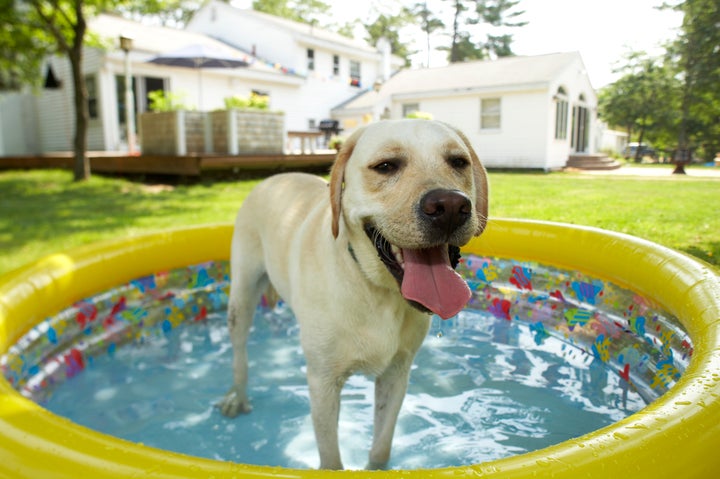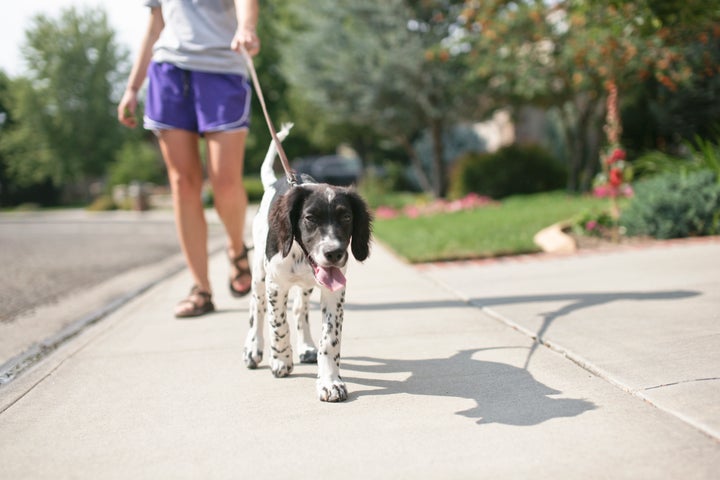Lovely as the warm weather is, when temperatures rise it can also be an uncomfortable time of the year for your dog. Here are five ways you can keep your dog cool and comfortable during these hotter months.

1. Keep a watchful eye out for ticks
Ticks become more active in warm and humid weather, but remember, these nasty parasites are a year-round danger. Hotter, wetter weather conditions in Europe, increasing numbers of hosts such as deer, and more pets travelling abroad, mean it’s necessary to protect your dog year-round.
Ticks may be the size of a sesame seed when unfed, but once completely engorged with your pet’s blood, they grow to around the size and shape of a coffee bean. They look for hosts to latch onto, often by climbing to the top of a blade of grass and waiting for passing traffic, like your dog. They can be found in open ground, rural and urban, and woodland areas - everywhere you and your dog like to walk.
Biting, licking, scratching and shaking are all symptoms that can alert you to the possibility that your dog might have ticks or fleas. But ticks aren’t just pests that feast on your dog; they can also be carriers of some serious diseases for humans and dogs including Lyme disease, which adversely affects both muscle and nerve cells.
Ticks can be removed by hand, but you must ensure they are removed correctly using either fine-pointed tweezers or a specially designed tick hook. As ticks are so small and easily missed, protection is an important part of keeping your pet safe. To ensure you use the most effective treatment for your dog, speak to your veterinary surgeon. The options include topical medicine (typically applied every four weeks), sprays, collars and oral chewable formulations, some of which can give up to 12 weeks of protection. Read more about ticks and the Big Tick Project, the largest veterinary study of ticks and tick-borne disease in the UK.

2. Help your dog stay cool on hot days
Unlike humans, dogs can’t sweat through their skin and so they rely on panting and releasing heat through their paw pads and nose to regulate their body temperature and keep cool. Imagine being stuck in a thick winter coat on a hot summer’s day and you’ll understand how dogs can suffer fatal heat stroke within minutes. Once your dog shows signs of heatstroke - including collapse, excessive panting and dribbling - the damage is already caused, which is why it’s so important to, once again, take preventative measures to help your dog beat the heat before it’s too late.
These include:
- Leaving a number of constantly topped up water bowls around your home in shady areas.
- Walking your dog in the early morning or evening (more pleasant for both of you!)
- Filling a paddling pool with a few inches of water and letting your dog cool down with a liquid lounge.
- Avoiding extended periods of direct sunlight between 11am and 3pm.
- Never, ever leaving your dog in a hot car, however quick you think your errand might be.
- Clipping longhaired dogs’ coats.

3. Check your dog for fleas regularly
Fleas thrive in warm and humid weather and can cause extreme irritation for your dog. Once your dog has fleas he will bring them into your home - your carpets, your sofa and your bed linen, could all be affected. In fact, it’s estimated that while 5% of the fleas will be on your pet, 95% will have dropped off and be infesting your home.
Spot ticks or fleas by taking a close look at your dog’s skin, pushing back the fur around their neck, ears, belly and tail. If you spot any nasties you will need to treat both your dog and your home as there will be eggs, larvae and pupae infesting your home.
So, just as with ticks, prevention is best through thorough daily grooming and speaking to your vet about a preventative treatment. These options include topical medicine (typically applied every four weeks), sprays, collars, and oral chewable formulations, some of which can give up to 12 weeks of protection.

4. Protect your dog’s paws from the hot surfaces
Blisteringly hot pavements, concrete and other hard surfaces can all cause your dog unnecessary discomfort during this time of the year. Remember holiday occasions when sandy beaches were too hot to step on barefoot; now imagine what it feels like to be made to walk across that painful surface by an oblivious owner. Take care of your dog’s delicate paws. If the pavement is too hot for your hand, it’s too hot for your dog’s paw pads. Walk your dog at cooler times and in the shade to prevent their paws burning.

5. Ensure your dog doesn’t eat anything harmful
Warm weather means more people out in parks and woodlands; more picnics, outdoor drinking and barbecues - and, sadly, more litter. At this time of year, stay extra alert when walking your dog, to prevent them from eating anything harmful. For example, mouldy bread full of toxins that can cause stomach upsets or chicken bones that risk splintering and obstructing his throat.
It’s also essential to keep an eye out for left-behind dangers to delicate paws, such as broken glass.
MSD Animal Health believes there’s nothing ordinary about the connection between pets and their owners and that keeping your pet healthy and happy will allow you to enjoy all the benefits of giving them plenty of love and attention. The Big Tick Project is the largest-ever veterinary study of ticks and tick-borne disease in the UK - find out more on The Big Tick Project website or Facebook page.